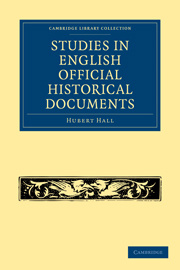Book contents
- Frontmatter
- PREFACE
- Contents
- ERRATA
- PART I THE SOURCES OF OFFICIAL HISTORICAL DOCUMENTS
- PART II THE DIPLOMATIC OF OFFICIAL HISTORICAL DOCUMENTS
- INTRODUCTION TO THE DIPLOMATIC STUDY OF OFFICIAL DOCUMENTS
- THE ANGLO-SAXON CHARTERS
- ANGLO-NORMAN CHARTERS AND WRITS
- LATER CHARTERS AND DIPLOMATIC INSTRUMENTS
- LETTERS, STATE PAPERS AND DEPARTMENTAL INSTRUMENTS
- ROYAL SURVEYS, INQUISITIONS AND ASSESSMENTS
- ROYAL ACCOUNTS
- JUDICIAL PROCEEDINGS
- APPENDIX I A Classified Table of Diplomatic Instruments
- APPENDIX II Early Diplomatic Criticism
- APPENDIX III The Charters of King Athelstan (Concordance of Formulas)
- APPENDIX IV Table showing the Relationship of the Pre-Conquest and Post-Conquest Diplomata
- APPENDIX V Documents connected with the Issue of the Great Seal (1662)
- APPENDIX VI Fees of the Seal
- APPENDIX VII Note on the Bibliography of English Diplomatic
- PART III THE PALAEOGRAPHY OF OFFICIAL DOCUMENTS
- TABLE OF MATTERS
- Frontmatter
- PREFACE
- Contents
- ERRATA
- PART I THE SOURCES OF OFFICIAL HISTORICAL DOCUMENTS
- PART II THE DIPLOMATIC OF OFFICIAL HISTORICAL DOCUMENTS
- INTRODUCTION TO THE DIPLOMATIC STUDY OF OFFICIAL DOCUMENTS
- THE ANGLO-SAXON CHARTERS
- ANGLO-NORMAN CHARTERS AND WRITS
- LATER CHARTERS AND DIPLOMATIC INSTRUMENTS
- LETTERS, STATE PAPERS AND DEPARTMENTAL INSTRUMENTS
- ROYAL SURVEYS, INQUISITIONS AND ASSESSMENTS
- ROYAL ACCOUNTS
- JUDICIAL PROCEEDINGS
- APPENDIX I A Classified Table of Diplomatic Instruments
- APPENDIX II Early Diplomatic Criticism
- APPENDIX III The Charters of King Athelstan (Concordance of Formulas)
- APPENDIX IV Table showing the Relationship of the Pre-Conquest and Post-Conquest Diplomata
- APPENDIX V Documents connected with the Issue of the Great Seal (1662)
- APPENDIX VI Fees of the Seal
- APPENDIX VII Note on the Bibliography of English Diplomatic
- PART III THE PALAEOGRAPHY OF OFFICIAL DOCUMENTS
- TABLE OF MATTERS
Summary
The ancient system of Account known by the comprehensive title of the Compotus can be clearly shown to have existed contemporaneously with the diplomatic writings in use under the civilization of the later Roman Empire.
It is true that the persistent employment of the symbols known as Dicae, tallies, and numerales acervi (“jettons”) down to a comparatively modern period would seem to indicate an aversion from clerical accounts in the archaic practice of the Exchequer itself. It is not, however, in this direction that we shall find the connecting links between the practice of the royal Exchequer in England in the 12th century and the continental system from which the diplomatic arrangement of the conventional Account must be derived.
The practical necessity of administering princely estates by some closer system of reckoning than that of the notched stick gave rise to an official formula which is the characteristic feature of the manorial Account evolved from the agrarian survey of the 6th century. Here a Descriptio of the tenement is combined with an Imbreviatio of the stock, both being ascertained by means of a sworn Inquisitio.
But besides these periodical valuations, we have references, under the Frankish system, to yearly manorial accounts in which the Receipts, Disbursements and Balance are carefully distinguished. In this distinction we may recognize the germ of the later conventional manorial account which is arranged on a similar plan for entries of stock or cash.
- Type
- Chapter
- Information
- Studies in English Official Historical Documents , pp. 307 - 310Publisher: Cambridge University PressPrint publication year: 2010First published in: 1908

